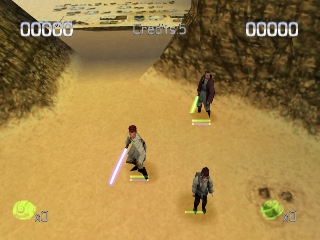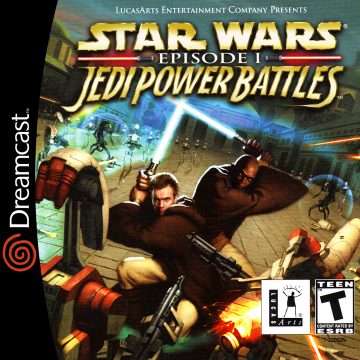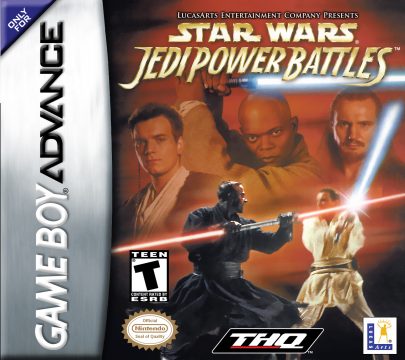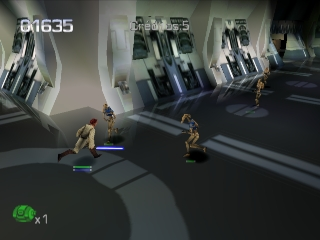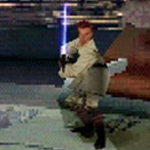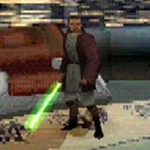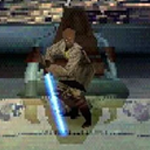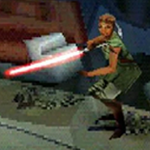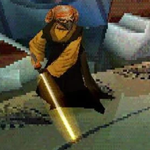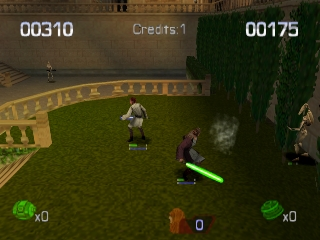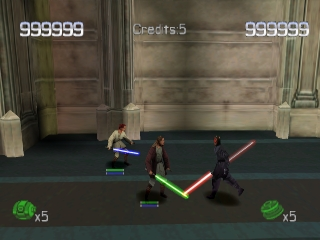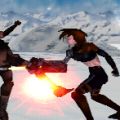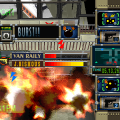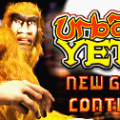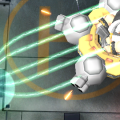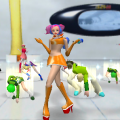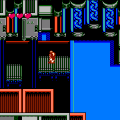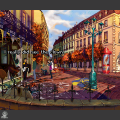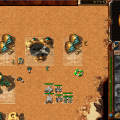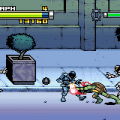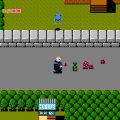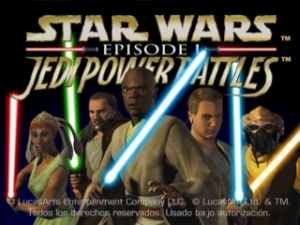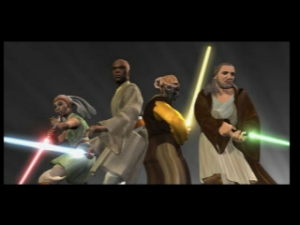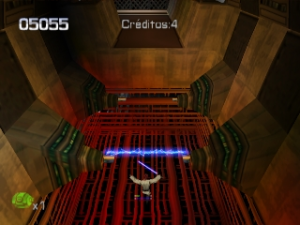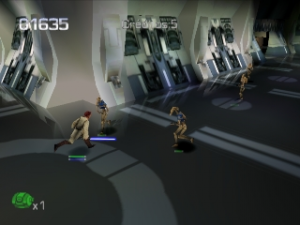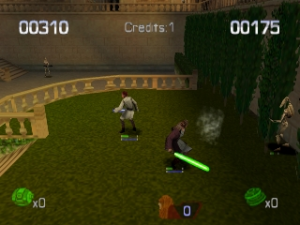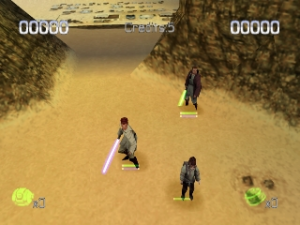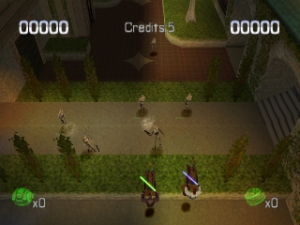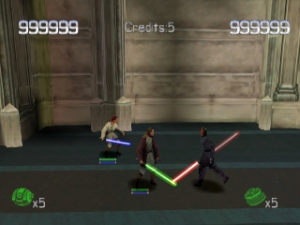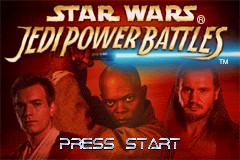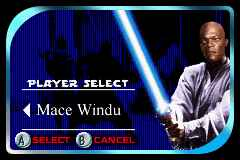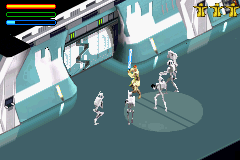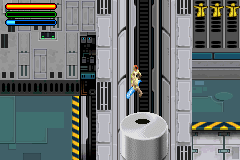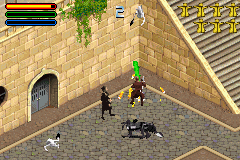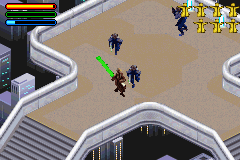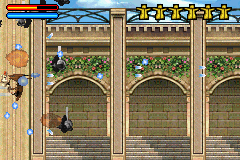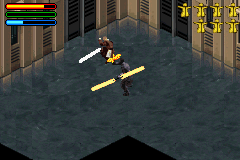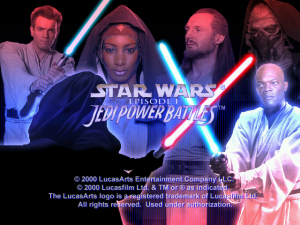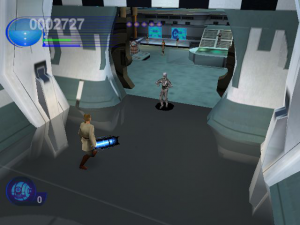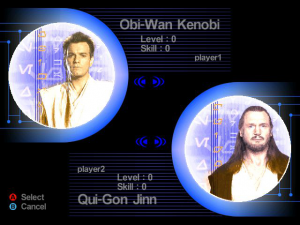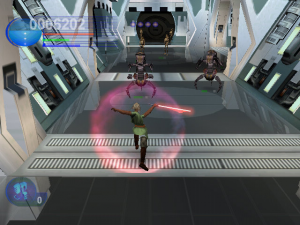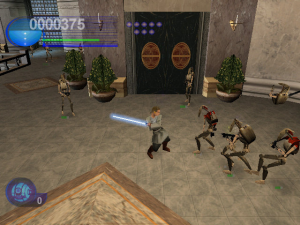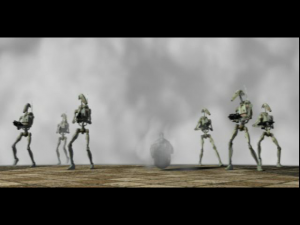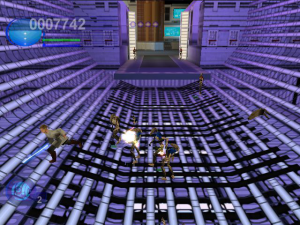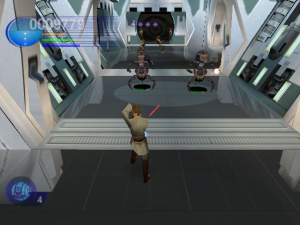Out of more than a hundred videogames based on the Star Wars expanded universe, Jedi Power Battles stands out for having been one of those titles whose different versions happened to be quite dissimilar from one another. The people behind the scenes responsible for the development of the first two versions of the game were none other than the legendary LucasArts guys themselves (currently known as Lucasfilm Games) whose creative genius, as we all know, gave rise to unforgettable experiences like Indiana Jones, Maniac Mansion, Monkey IslandandThe Dig, to name a few. However, they were not able to produce Star Wars related games up until 1992, due to the license being held by Broderbund; but starting from the following year, they managed to plant the seeds for future successful sub-series like X-Wing, Rebel Assault and Dark Forces.
However, Jedi Power Battles may arguably be considered not as successful as the previously mentioned titles, due to specific factors like the high difficulty in certain versions or the confirmation of LucasArts’s fears of the early 2000s, meaning that the over-reliance on the Star Wars franchise was supposedly leading to a decrease in the quality of the outputs. As for this title, like many others, it is set during the time frame of the movie Star Wars: Episode I – The Phantom Menace and is mainly defined as an action game sprinkled with not always successful beat-em-up and platform elements. The characters were obviously developed not only drawing inspiration from the Jedi who actually appeared in the movie but they were assigned unique abilities and special lightsaber and Force moves to make these warriors more peculiar. Now, highlighting all the distinctions from the three different versions usually requires an in-depth analysis of the entire game, leading sooner or later to spoilers of some sort. Please be advised.
The first version came out for the PlayStation in April 2000 and was later followed in October by the Dreamcast version, which brought an improvement in graphics thanks to a higher resolution and had the gameplay reaching 60 frames per second. Darth Maul was also properly fixed in this version as an unlockable character, meaning that he finally displays his famous double-bladed lightsaber, unlike the single blade found in the PlayStation. Character animations were also overall improved, as well as the platforming sections. The final version came out the next year and was developed for the Game Boy Advance by HotGen Studios (and published by THQ) and, according to several aggregators, it is simply defined as the worst one.
Both the first two versions give you the possibility to pick your Jedi from the five available at the start, equipped with a “bomb” ability called Special Item (“Because he’s holding a thermal detonator!”) of which you can carry a maximum of four altogether, a Force ability (with the possibility of unlocking more of them as you progress in the game) and five lives called Credits. Instead, the handheld version only allows you to choose from three starting characters. A keen eye should also be able to notice that the Dreamcast title is the only one displaying the names of the Jedi both in the regular alphabet and in the Aurebesh alphabet, an elegant detail for the most hardcore fans.As for the soundtrack, the first two versions have it very similar to the movie (in fact, almost all of it is made directly stealing parts of the songs from The Phantom Menace’s score) while the Game Boy Advance version has its own. Lastly, just before diving into the game, you are allowed to choose the difficulty level, Easy mode or Jedi mode; however, oddly enough, they are exactly the same and although the booklet will tell you that secrets can only be unlocked in the hard mode rest assured that this is totally untrue.
Characters
The fast Obi-Wan Kenobi, the only selectable apprentice (he is Qui-Gon Jinn’s padawan), comes with a blue bladed lightsaber and the quick and useful Saber Dash as his default Force Power, while Protection Bubble and Force Thrust are made unlockable in the next levels. His Special Item is a Thermal Detonator.
The experienced Qui-Gon Jinn is a Jedi Master and Obi-Wan’s mentor. Despite being sometimes portrayed as weak in the movie, he is actually an excellent fighter with his green bladed lightsaber and possesses great Force powers, which are Shockwave, Heal and Force Burst. He also holds an Electric Detonator.
Mace Windu, Jedi Master and respected member of the Jedi Council, holds a blue bladed lightsaber (although his original has a purple amethyst color), a Thermal Detonator and three Force powers: Saber Shield, Force Absorbe, Saber Throw.He is surely second only to Master Yoda as for authority, experience and knowledge. His Force powers are the strongest ones and he is overall the best balance in speed and combos.
The elegant Jedi Master Adi Gallia, born into a high-ranking diplomatic family on Coruscant, is one of the two non-human selectable Jedi (she is Tholothian). She wields a crimson bladed lightsaber (while it is pure red in her other appearances of the Expanded Universe) and, along with an Energy Shield, she has three Force powers: Mesmerize, Piercing Gaze and Force Cloak. She may not be the strongest selectable character but she surely is the fastest one and the best in doing combos.
The last selectable character is the Kel Dor Jedi Master Plo Koon, usually defined as the slowest but also the strongest: he holds a Stim Pack and has three powers which are Saber Cyclone, Electric Judgment and Protection Bubble. He comes from the gas and helium-rich planet Dorin and wields a yellow bladed lightsaber. It is said to be excruciatingly difficult beating the final boss of the game with this Jedi, due to his poor combos. It is interesting how the dark Force power called Electric Judgment, rarely used for good, is used by Plo Koon. Only true masters of the Force can wield it and, consequently, Plo is obviously one of them.
Now, as for the secret unlockable characters, there is a Battle Droid character which is a Dreamcast exclusive and has an Electric Detonator, a blaster and melee moves (and can be unlocked by completing the first level with all the initial five Jedi). Queen Amidala and Captain Quarsh Panaka (both unlockable by beating the game with Obi-Wan) are more or less the same, both holding a Thermal Detonator and a blaster. Darth Maul, who is the final nemesis, is also an unlockable character if you beat the game as Qui-Gon Jinn (it is the only secret character of the Game Boy Advance version) who holds, in the first two version of the game, a Thermal Detonator and three Sith powers: Force Disruption, Force Lighting and Force Sphere.Jedi Master Ki-Adi-Mundi is the last Dreamcast exclusive: he is a Cerean and he holds a blue lightsaber and Electric Detonator. Mesmerize, Force Cloak and Saber Throw are his powers, with the last one having a longer range than the one of Mace Windu.
After choosing his favorite Jedi among the ones available (Adi Gallia, Mace Windu, Obi-Wan Kenobi, Qui-Gon Jinn, Plo Koon for the first two version or Obi-Wan, Qui-Gon, Mace Windu for the handheld one) the player starts with a first impact of the game on the Trade Federation Battleship, ideally following the plot of the movie. He is welcomed by a barrage of blaster shots by many Trade Federation Droids (which you can fight alongside a friend, thanks to the co-op mode), leading the player to quickly learn how to deflect them with the lightsaber and how to properly do the available double-jump in order to progress through the many not-always properly designed platforming areas, while picking-up power-ups whose sound design clearly resembles the laugh of a famous 900 years old Jedi Master (and these are Health, Force, your “bomb” item, Blade Amplifier, Blade Extender, Checkpoint, Point Bonus, Extra Life, Challenge, Randomizer, Ultimate Power-Up and Gungan Artifact).
There are big graphical differences between the three versions, starting from a totally different lighting setup. Environmentally, the PlayStation title is the only one allowing you to destroy “computer platforms”in exchange for extra points but this might be the only win for this version since, for example, the Dreamcast game looks “cleaner” and fixes much more important elements like many platforming sections. As for the enemies, the first two games feature many different types of droids including the Destroyer Droids and in the Game Boy Advance version this last type do not have Force Fields to protect them.The mid-boss is a Loader Droid while the final boss is a Starfighter Droid who can transform in a way that makes it more adapt to infantry combat. This final boss also allows you to somehow master your deflecting ability in the most hardcore way, if you want to avoid countless deaths.
The second level is located in the Swamps of Naboo and the three versions here are more similar to each other.The final boss is a Slaatik Hagworm, an enormous bug who will attack you by spewing poison while in the Game Boy Advance you will fight a Gungan-like boss.
The third level is the City of Theed and here you will have to rescue the Queen’s handmaidens but in the Dreamcast version there are also other citizens running around. For this level, this version is very similar to the PlayStation one, with only minor differences like the color of the Armored Assault Tank and the final boss shield and lasers. Again, the PlayStation version allows you to destroy scenario elements while the Dreamcast doesn’t. Interesting how riding a tank here is optional and, if you choose so, you can do the entire level by foot.
The fourth level is the Theed Palace. Here we find again big differences in aesthetics and platforming, meaning that they eased some jumps in the Dreamcast version and made the path to follow easier to guess; here, they also added smaller versions of the final boss of the third level together with some Grapple Droids that somehow resemble the final boss of the Game Boy Advance version. The final bosses of the PlayStation are big Plasma Droids.
The fifth level is Tatooine, which is generally similar in all versions: the biggest differences are found in the Sand People’s homes (they are also known as Tusken Raiders or simply Tuskens). In the Dreamcast version there is a specific spot where you will be forced to fight many Sith Probe Droids (an interesting hint on who will be the final boss) while there is no such thing in the PlayStation. After surviving the surroundings of the Sarlaac’s Pit you will encounter the mid-boss, an Armored Krakkiss, while at the end of the level you will meet for the first time none other than Darth Maul himself, resembling that mid-scene from the movie. The worst part of this level is surely the frustrating section in the Game Boy Advance version where you have to escort the young Anakin Skywalker but to be fair this level is overall enjoyable even in this handheld version.
The sixth level is Coruscant and scenarios are pretty similar to each other with an honorable mention to be given to the Game Boy Advance version thanks to the beautiful retro futuristic aesthetic of the skyscrapers. Designers did a good job as for the enemies’ variety in this scenario. It is an interesting level but also one of the longest and the grind can be sometimes frustrating. However, we also witness some funny glitches that will make this fatigue easier to bear like mercenaries timely suiciding themselves in impossible ways or frantically running while standing still in the same spot.The final fight against the Mercenary Leader is interesting, with a lot of martial arts and teleporting involved.
Level seven is the Ruins and it brings us back to another part of the Swamps of Naboo. The graphical environment is pretty much the same apart from a giant face statue which is a Dreamcast exclusive. Enemy placement here is a little more different to the other version than it is for the previous levels, being them usually closer to each other. This level brings back our Plasma Droids friends and also introduces Gungan guards (who just run away when defeated, maintaining the movie rule that they are on the good guys side) and Carnivorous Plants. The platforming is somehow awful but the worst part is undoubtedly a certain jump section in the handheld version where you basically have to repeat it dozens of times either because of colliders were badly placed during development or because your double-jump just won’t work properly and all this while your health bar keeps being progressively lowered by blaster shots or gravity, leading even the most patient gamer of the planet to rage quit. The final boss is a Gungan Chief.
The eight level is set in the Streets of Theed and you basically pilot a STAP (Single Trooper Aerial Platform) throughout the whole level, leading some to question if it should just have been a mini-game instead of a whole level. The Game Boy Advance version actually wins this time as a 2D side-scrolling level which is more enjoyable than its two 3D counterparts.
Level nine is the Palace Cliffs and it is frustrating to say the least: you have a time limit and you have one of the worst platforming of the whole game, leading you to die so many times due to its poor design. In all of this, you also have to free five Naboo Pilots. Bonus points again to the handheld version, because at least here you do not have a time limit.
The last level is the Final Battle against Darth Maul himself. The battle is way harder in the PlayStation version while the graphics look similar and gameplay-wise they are not so different from each other, with the PlayStation version being a little more difficult. Interesting how this is the only level of the Dreamcast version where you can destroy a scenario element (the fans control panel) and here you also have a little custom cutscene for Darth Maul’s death. As for the handheld version, the platforming is again at its worst since the double-jump will simply not work (interesting how the programmers’ names simply do not show up in the end credits).
Now, in the PlayStation version there are four bonus levels: the firstis both on this version and on the Dreamcast where you simply play as a Droideka, rolling around while killing Naboo Pilots and some Jedi at the end; but the next three bonus stages are PlayStation exclusive, with them being a Kaadu Race (where you simply tap buttons as fast as you can to move faster and win the race), a Gungan Roundup where you just stab Jar Jar Binks in order to have him running to your bubble and earn bonus points. The last bonus mission is just a Survival Challenge where you fight waves of enemies (100 in total, 10 of each type) with your Jedi, one Credit and very few power-ups; if you manage to successfully complete this quite hard mode, you’ll be rewarded with the possibility to play the game with the Ultimate Lightsaber, almost resulting into a one-shot one-kill mode (this doesn’t work with the bosses, though). Ki-Adi-Mundi can only be unlocked by beating the seven Dreamcast exclusive training mission in a row, with time limits (an interesting Easter egg has his name appear in the PlayStation version as well). Moreover, Dreamcast only, you have the Versus mode, where you can fight a friend by picking one of the many characters available in the game, including some bosses. The Game Boy Advance version simply doesn’t have any bonus levels whatsoever.
It would be an exaggeration to define Jedi Power Battles as a failure: after all, the Dreamcast version received generally favorable reviews and the gameplay experience is enjoyable in the PlayStation version as well, at least in some of the levels. It may be, as Fran J. Ruiz puts it, another example of “unpolished charm”, meaning that the game would surely have benefited from few more months of development (and hints like the two difficulty modes being the same may prove that) but it is at the same time unique in its own genre. We all know that there is only a thin red line separating subjective opinions from factual analysis (even when talking about the biggest names in videogame critique and review websites) which often deems it difficult to obtain objective conclusions. Luckily, in this case, there are at least some elements of unplayability on which we can all agree to a certain extent, like the impossible jumps of the Game Boy Advance version or the frustrating platforming in the Palace Cliffs level for the PlayStation one. Does this make the Dreamcast version immaculate? Not at all, especially if we consider its horrible main menu layout or a certain encounter with a child mercenary amidst Coruscant’s skyscrapers, the closest thing to killing a youngling that you’re gonna get in this game. Maybe not annoying gameplay-wise but surely controversial.
Links:
A Short History of LucasArts – Interesting and essential retrospective on LucasArts provided by the staff of Edge which explains, among other facets, the fears that the company had in the early 2000s. https://web.archive.org/web/20131012110136/http://www.edge-online.com/features/short-history-lucasarts/
Jedi Power Battles Hands-On – Ben Stahl of GameSpot providing straightforward insights on the main differences between the three versions of the game.https://www.gamespot.com/articles/jedi-power-battles-hands-on/1100-2616086/
Retro Game Review – Star Wars: Jedi Power Battles – A brief retrospective of the game by Fran J. Ruiz of SWNN which highlights some elements that can be easily missed out just by playing it. https://www.starwarsnewsnet.com/2020/04/retro-game-review-star-wars-jedi-power-battles.html
Rogue Leaders: The Story of LucasArts-An indispensable resource on LucasArts’s history, from its beginning in the late 80s until 2008, the publication year of this book.
Star Wars Episode I: Jedi Power Battles – Guide and Walkthrough – It may not seem at a first sight but this is not a walkthrough guide.It is rather a treasure chest full of analyses and hidden secrets, carefully explained by ChefGhost. https://gamefaqs.gamespot.com/ps/250628-star-wars-episode-i-jedi-power-battles/faqs/13837
The Games of Star Wars – Very brief, interesting and funny comment on the game by Tom Charnock of The Dreamcast Junkyard. Notes on the other games are worth reading too. https://www.thedreamcastjunkyard.co.uk/2015/10/the-games-of-star-wars.html#more
